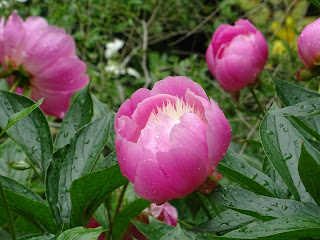We looked round the gardens in New
College. Parts of Harry Potter were filmed here. I can’t remember which bit of
which film it was, but a young girl standing nearby heard us talking and filled
in all the gaps!
Graffiti is not allowed on the walls of
the college unless you win a boat race. There were two such celebrations
depicting the year and the team. Underneath one, it read “5 bumps” with a row
of decorated oar fins. As we stood there trying to work out what that meant, a
student appeared through one of the doors. “Do you know what 5 bumps means?”
Sheila asked him. He thought for a moment. “I’m not a rower. But I think it’s
how many times they “bump” a boat in front.” Arhh. “Thank you.” “You’re
welcome,” he said, and disappeared into another door across the courtyard.
The rearmost garden in the college is
surrounded in part by the city wall, which pre-dates it by several centuries. The
college founder needed to commit to maintaining it in order to buy the land. Every
three years the Mayor and Mayoress of Oxford circumnavigate the wall-top path
to ensure that the obligation upheld.
Inside the garden is a decorative mound
commissioned by Elizabeth I. Although there are steps to the top it is
forbidden to climb them. Around the edge are beds with flowers and shrubs. There
were two gardeners tending them today and I left Lisa and Sheila discussing
plants while I wandered about further. I know nothing about gardening and I’m
afraid the green stuff in my garden needs to be able to look after itself if it
wants to survive.
As I wandered back to the three of them,
still talking, Lisa spotted a squirrel. “Huh!” said the gardener. “Your cute
little squirrels are vandals. We planted 350 tulip bulbs last year. Do you know
how many the squirrels ate?”
“249?” I ventured.
“Something like that! We don’t plant
tulips anymore.”
Before we left New College, we visited the
chapel. Standing opposite the doorway, with his back to the altar but twisting
his head round to catch a glimpse, is Epstein’s sculpture of Lazarus. The
carved stone folds of the bandages he is wrapped in are very intricate and the closer
you study it, the more detail you discover.
On leaving New College, we passed Edmund
Halle’s house, with its high up observatory where he studied the comet named
after him. Also in that street is Oxford’s Bridge of Sighs, modelled on the one
in Venice, decorated more like The Rialto Bridge. Then we were back to Broad
Street.
Our last stop was a fairly recent
addition to the Bodlean. Inside were two free temporary exhibitions. The first
was entitled “Shakespeare’s Death”. It wasn’t actually about his death but
about the many ways in which he portrayed death in his plays.
The second contained many historical
pieces of writing and some early books with ornate bindings. There was the
Magna Carta and the first recognisable map of the UK. There was a draft by
Wilfred Owen of his anti-war poem and posters from the Suffrage movement. There
was a sketch by J. R. R. Tolkein of Bilbo’s arrival at the Elves’ huts, an
early draft of Mary Shelley’s Frankenstein
and many other early examples of writing.
Lisa (www.wanderoxford.co.uk) left us at the entrance of the
exhibitions. Our two hour tour had turned into almost three. She had
entertained us and educated us, and we had only seen a tiny fraction of the
centre of Oxford. Her enthusiasm for her subject was infectious and we caught
the bug.




























